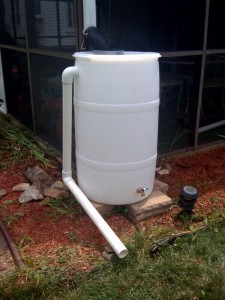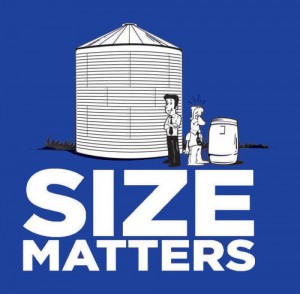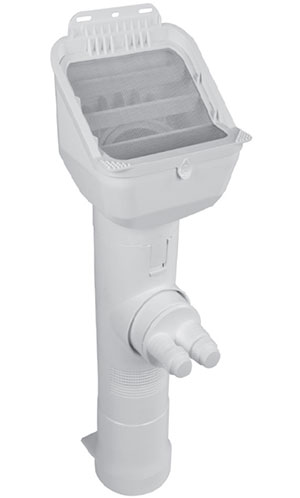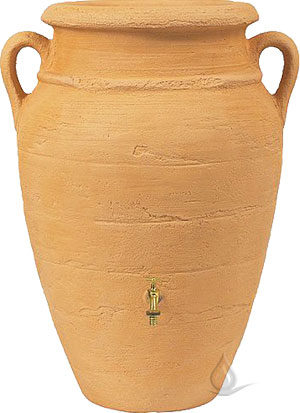Many organizations and municipalities are promoting rain barrels. While rain barrels are a form of rainwater harvesting, they only hold a small amount of water. They are promoted as the inexpensive or cheap solution to outdoor watering and they are. Water is one of the most important resources needed to sustain life and solutions for its use are usually sought out as the low hanging fruit or the cheap solution.

Syrup Barrel
Why do we want to store something so special cheaply. Properly designed rain barrels offer a great storage vessel for patios and small gardens. However, rain barrels when not designed properly, usually becomes a source of algae blooms and messy cleanings. Many of the workshops now encourage painting to limit the light that encourages algae growth, but few if any incorporate the first flush which diverts the organic materials that feed the algae. Algae blooms involving toxin-producing species can pose serious threats to animals and humans. To learn more about Algae at the Water Encyclopedia click here. Why store dirty water that can be used for cleaning and watering. Why use bleach to kill the algae and water plants. Rainwater can produce 20-30% more plant growth then chlorinated or domestic water. Properly captured rainwater can be stored for months in hot climates untreated.
The small volume of storage cannot hold enough water to last through long unexpected droughts for large gardens. The small volume does little to help reduce stormwater surges in urban areas when compared to the large surface areas of roofs. Even though the workshops promote the stormwater benefits, only a few hundred gallons of water can be captured from one downspout during a normal rain event.
Coke promotes rainwater harvesting by giving away thousands of clear plastic barrels across the country. Will it really help? Sounds good on paper. I would rather see a closed loop recycling of food grade plastics. Good intentions, but not a lot of information about the practice of rainwater harvesting. The American Rainwater Catchment Systems Association, Harvesting Rainwater and Harvest H2O are a great source of information and educational resources.

Art work courtesy of RAIN HARVESTING SUPPLIES.
I am not opposed to rain barrels I just want them to have their place in the practice of rainwater harvesting. Many of the people I have approached in my business use hundreds to thousand of gallons per month for irrigation and outdoor water use. Many think a few rain barrels are the answer and/or want something cheap. Most rain barrels only hold about 5o gallons of usable water per container and to store 500 gallons it would take 10 to 12 barrels. One 500 gallon tank is 48″ in diameter and 72″ high or 67″D x 42″H. This would be much easier to hide or place then 10 rain barrels.
Home owners spend of thousands and thousands of dollars over time on landscaping and water features for their yard. They need to learn to pay for the infrastructure to support and insure their investment. I believe rain barrel workshop attendees should be required to bring water bills. Water bills that track the use for a year are great or bring a January, July and August bill to track out door use and compare in door to out door or summer to winter use. Subtract the winter use from the summer use equals outdoor use.
The rainwater/stormwater benefits need to be explained to match the significant amount of water to of the total amount of impervious surface on the property. The water needs to be held until after the storm has passed and the water on the land has had a chance to soak into the ground. A house with a foot print of 1800 sq ft should collect about 1000 gallons of water to mimic predevelopment of 10% run off in its natural state,

Clean Rain
Rain barrels are sometimes called a gateway drug to rainwater harvesting. The term Gateway Drug was started as a myth by anti drug propaganda to inhibit the use of marijuana in the 60′s and 70′s. Now marijuana is legal in several states. Rain barrels are marketed as a cheap solution to our water problem, another myth. Real education is needed on water use and proper education for collecting our rain.
Adding a filter and first flush to the system, such as the Clean Rain, to the left, clean water can be stored in barrels. I installed 2 for a client and after about 1.5 years only the internal washers were replaced. She is very happy with the product. She uses them for her rain barrels, which supplements her 800 gallon cistern system.

Decorative Barrel
By designing systems properly in both size and components an adequate clean supply of water can be captured for non-potable use. Rainwater harvesting systems stores and supplies water for when it is needed during dry weather and droughts. If stored in potable tanks rainwater can be a source of emergency water. Why store smelly, oxygen deprived, toxin filled water to water plants, wash cars and clean things outside or add chlorine that inhibits plant growth. Rain barrels can be used for small gardens and house hold needs. Many come designed to blend into the surroundings.
By investing the proper time and money in rainwater harvesting, true appreciation of water and what it takes to provide a clean source can be obtained. A properly designed system will last for decades and is easy to maintain. Maybe some of the states that have legalized marijuana will hopefully lift some of the restrictions on rainwater harvesting.
Just my opinion.
An alternative or additional rainwater harvesting program utilities can use to promote and implement rainwater harvesting for their customers is my Self-Funded Rain Harvesting/Stormwater Utility. The utility allows rainwater users to pay for rainwater though the leasing of tanks and utilities to maintain or increase their revenue through rainwater. Click here to learn more.
